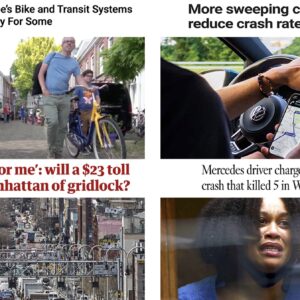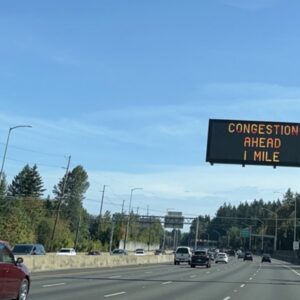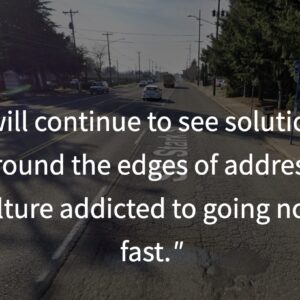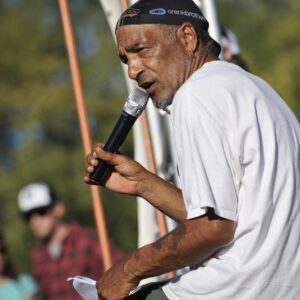I have been thinking about death lately.
First~ there is Vision Zero; there are my patients (I work with the end of life vision care); every month there are friends and acquaintances who face an earlier demise than the rest of us; and then there is Ragnar. Ragnar is in a soap opera that I watch faithfully and he keeps wondering what day he is going to die in his Viking world. He keeps seeing the Gates of Valhalla. He like us wants to know when the Gates will welcome him. And as much as ODOT/PBOT has a list of 100+ unsafe/dangerous intersections, we still never can predict which intersection doors of Valhalla will swallow another soul.
This leads me to think how can we change the things we can change.
As seen here before, I wish Vision Zero had a different tack in its maneuverings. I still think real analyses of Pedestrian Safety, Near Misses, Speed, Alcohol, Distraction, and many other variables are the real behaviors to attack rather than Death. It’s an ‘everyone feels good’ mantra to want to reduce deaths.
Statins, a lipid lowering medicine, is able to reduce mortality in pre-existing cardiovascular disease by producing 60% fewer heart events (not everybody dies with their first single heart attack) and reducing stroke risk by 17%. Last year, the American College of Cardiology extrapolated that ” approximately 10 million U.S. adults (who would be newly eligible for statin use) …are estimate(d) that between 41,000 and 63,000 cardiovascular events — heart attacks, strokes or deaths from cardiovascular disease — would be prevented over a 10-year period,” Of course there are a number of issues with taking statins (and a thousand sites pointing out the statin liabilities). But in the non scientific room of my mind, perhaps better safety road conditions might cut the 17% risk of a stroke bicycling the intersection of NE Williams & NE Broadway, where cars ignore the ‘No Turn on Red’ as they speed to enter I-5 North.
What is great about the cardiology group is that at the end of this report, they state “that a healthy diet, regular exercise, quitting smoking and managing your weight can all help protect the heart.” We try to get a drop in the bucket $4 million for Safe Routes to Schools which fulfills all the goals and encouragement of health and daily exercise against the backdrop of Americans spending about $100 Billion a year on statins. We still fail to reward physical activity.
It is the $100 billion and the lack of our culture to support and encourage physical activity that really makes me angry that Safe Routes to Schools is not the zenith effort of the Oregon Bicycle & Pedestrian Plan. My friend and peer, Dr. Scott MacRae in Rochester, NY distributed a great handout at the National Bicycle Summit in DC this March stating ‘sitting on your couch’ is more likely to kill you than a car. He cited many facts about how the lack of physical activity is killing us. Transportation policy action remains deaf that Oregon has a 28% obesity rate (2014) for children contrasted to the 1990 rate of 12%. It remains more frustrating that Transportation cannot integrate/promote a program that creates a daily physical activity in children at a premier level.
Safe Routes to Schools is more than just walking school buses. The program has a larger agenda that is not promoted & recognized. This agenda includes a multi-generational program: it teaches future people about traffic. This teaches traffic from a pedestrian perspective. These participating children will have a foundation in safety from the foot’s view not from glancing up from their ipads/phones looking out the automobile’s window while being driven to school. This program will teach people daily walking/bicycling is a physical activity that is the normal daily behavior in line with the American College of Cardiology.
I find it frustrating that this is one of the things we cannot seem to change among our leaders in transportation. I feel there is such a return to silo thinking. Many leaders in ODOT and PBOT and Metro and potentially JPACT refuse to change toward having a wide angle view including these generational influences to increase Health & Safety on many levels. This is ironic in my life. I know about 100 people who work for the 4 above agencies. They are progressive, inventive, smart, and have great concern for the health of our roads and people. Their ideas have a slow trickle to above the administrators’ glass floors. Metro rejected Safe Routes to Schools support on Mar 31st, 2016. And JPACT is about to vote yea or nay on April 21, 2016 for supporting Safe Routes.
These significant ground skirmishes defeat us. We need to replace several administrators and rekindle the philosophies of sustainability, integrate spending silos, genuinely elevate active transportation in every discussion of how people get from A to B, and finally prioritize monies for Health and Safety in transportation.
I fear that this will not happen.
I think Death will be a distraction to integration for better pedestrian & bicycle safety. Even this month’s declaration by Governor Brown’s War on Congestion leads us away from our infrastructure needs to reduce speed and increase safety. Brown stated at the City Club last week : “I will continue to champion much-needed seismic upgrades and other improvements to our roads, bridges and public transportation that enhance safety and address congestion. Congestion. If it seems to take a lot longer to get anywhere in the tri-county area than it did five years ago, that’s because – it does. Traffic delays in the Portland metro area are rising. Every commuter will waste an extra 52 hours this year fighting traffic.”
We like the idea that public transportation can be enhanced for safety, but Congestion is large weighty word masking where money will go.
The subtext of Brown’s speech is the tired notion freight and our economy are suffering at the hand of congestion on the highways; she is promising a larger transportation set of solutions coming our way next legislative session. Absent in these discussions is the national cost of crashes: $277 Billion dollars in 2010. “By behavior, alcohol involvement cost $59.4 billion, or 21 percent of economic costs. Speeding cost $59.1 billion, or 21 percent, and distracted-driving crashes cost $45.8 billion, or 17 percent of economic costs. Not using seat-belts accounted for $13.8 billion, or 5 percent of these costs.” (National Highway Traffic Safety Administration) $424 million is the estimate of crash costs in Oregon. And very sadly is the notion that more highway concrete is coming at the expense of Safe Routes to Schools, supplanting the needs 500 miles of sidewalks, and creating safer segregated lanes. Nowhere is the detail that segregated bicycle lanes will attract newer bicyclists. These bike lanes in turn reduce the # of automobiles being driven for 3 miles or less which composes half of all car trips. Simply getting more people on bicycles in safe zones will reduce congestion. We are missing a voice in Transportation that says Active Transportation is part of this solution.
In a way, we are already being preset to accept that congestion is the real issue. It is not crashes or deaths. The Travel Time Bill Boards tell all motorists how long it is going to take to get to I-5 or to Powell Blvd…this pumps every driver’s statin filled heart to realize there are others ahead of them on the road. This constant daily Time report on the highway seems like a good piece of information to know…but I wonder if it will only make the frustrated more aggressive. This is a savvy raison d’être to keep reminding motorists how congested we are in order to validate constructing more lanes of car/truck traffic.
Frankly, this is a place where Vision Zero should campaign for equal time. Perhaps we should be putting the total number of deaths right above the travel time to I-5 or Powell on the bill boards. Vermont set up electronic message boards on state highways to display the number of people who have died in highway accidents. Why not us? We are ignoring so many variables that are crying for attention, knowing the day you are going to die may be very unimportant compared to walking to school, telling loved ones that they are loved, and living life to the best of our abilities. And poor Ragnar did fall several stories while trying & failing to conquer Paris ~only to come back for another season. If only we could convince our top level decision makers that not only deaths matter but the daily living habits of health & safety in transportation are the most important issues instead of 5 minutes to Powell Blvd.
~AJZ
Z Note: These thoughts are as I bicycle to and fro Oaks Bottoms from my home in the northeast the past several weekends. I apologize for any tangential vagrant word & rambling, but I hope you can see the stream of consciousness. References for some details at http://www.72km.org/death—congestion.html.
~AJZ
— Only subscribers can post in this section, but everyone can read and comment. Learn more about our subscription program here.





Thanks for reading.
BikePortland has served this community with independent community journalism since 2005. We rely on subscriptions from readers like you to survive. Your financial support is vital in keeping this valuable resource alive and well.
Please subscribe today to strengthen and expand our work.
I agree that we should ask for death counts (and serious injuries) on digital reader boards.
But as to the effect of showing the expected travel time on such billboards, I think it may decrease people’s frustrations with being “stuck in traffic” (that they are part of causing). Knowing how long something will take allows people to relax into it, rather than be constantly frustrated. It’s why at Disneyland they have the “30 mins to the front of the line from this point” signs (or at least used to).
ODOT claims their readerboards have been successful, I think in both decreasing delays and crashes. Can’t find the press release right now, so don’t quote me on it.
what if reader boards also included the average cost of waiting in 30 minutes of traffic. This traffic jam is costing you $10. Combining average pdx wages, wear on car… My hope would be that people would decide to live closer but it could backfire and result in people demanding bigger freeways in the illusion that that will relieve congestion
Huh.
“…showing the expected travel time on such billboards…may decrease people’s frustrations with being ‘stuck in traffic'”
This is very interesting, and I also suspect, true. Maybe this is why riding to work is usually less stressful than driving—it’s less of a crap-shoot (at least time-wise; there are other dice to be rolled when riding…). Even riding, there are a couple of places on my normal route where I get stuck in auto traffic if it exists, and I find my frustration level rising quickly when I come over the rise and see a back-up of car traffic that I’m going to have to wait in. These back-ups seem to appear on arbitrary (and rare) days, so I never really expect them, which is probably why they have a negative effect on me. Maybe that’s the real root of so many roadway problems: unmet expectations. Expectations of speed, expectations of a clear and empty road, expectations that certain others will stay out of my way, expectations of safety and comfort, etc.
Those ODOT reader boards are in my view a first order example of how ODOT misspends our money. No one asked for them; ODOT didn’t even initially know who to pick as the target audience. We have hundreds of worthwhile, even essential, projects that one could spend money on—as AJZ notes in his article—and what does ODOT do? They dream up some nonsense digital highway project and dismiss calls for sensible spending priorities.
Here’s a bit of information I found when looking into these signs a few years back: http://bikeportland.org/2014/12/15/guest-article-four-things-bikeloudpdx-learned-campaign-se-clinton-117493#comment-6003599
Quote from article above: “This leads me to think how can we change the things we can change.”
Try suggesting that cyclists take the bare minimum responsibility for their own safety by making themselves more visible so drivers can see them more easily. See what happens to you – you’ll be attacked just like a baker who, for justifiable and reasonable reasons, does not want to participate in certain weddings; or a mother/father who, for justifiable and reasonable reasons, does not want a man using the same locker room as their daughter. Most folks who read this website have little interest in “changing the things we can change”. So much for vision zero, but it’s good of you to try.
“change the things we can change”
“bare minimum”
I’d like to know what the “bare minimum” ought to be. Legally, with respect to visibility and equipment, the “bare minimum” for night operation is a front white light visible from 500 ft. and a red rear reflector visible from 600 ft. when illuminated by the lawful low beams of car headlights. What else should we add to that? Helmets? Should I wear my helmet even when I’m cruising at 10mph on the neighborhood MUP or through a park? What color of helmet should I use, something with reflective elements or a “hi-viz” color? Do I need to have a helmet-mounted light? Or would that be beyond the “bare minimum”. How about clothes other than a helmet? Are “hi-viz” and reflective arm/leg bands enough? Would that be the bare minimum, or would one need to wear an entire shirt or jacket that was some hi-viz color, including reflective elements (how many square inches of retro-reflectivity would be considered the “bare minimum”)? Should I use an orange flag on a 10-ft pole to be more visible? What about using a noisemaker of some sort (sirens and whistles are illegal, but maybe a constantly-ringing bell?) so I can “be heard”? Should I be required at a bare minimum to use a rear-view mirror?
Many, many bicyclists have been hit or run over by cars (including me) while going far, far beyond the legal “bare minimum” of concern for one’s own safety. In my own case, I was hit where a “bike path” (MUP) turns into a crosswalk, while crossing in the crosswalk (after legally approaching the crosswalk at a speed no greater than an ordinary walk), with the walk signal, while wearing bright orange and using 800-lumen flashing lights during daylight hours. Was I obviously not quite up to the “bare minimum” since I still was not seen? Or was the driver who hit me not quite following the “bare minimum” safety protocols (and the law) by failing to stop for a red light prior to entering the crosswalk, and failing to see a bicyclist directly in front of him (especially since there is a BIKE X-ing sign as drivers approach this intersection)? Christeen Osborn was hit while riding on the Oregon Coast bicycle route (shoulder of hwy. 101) while wearing a bright, day-glo green safety vest during daylight hours by a lady who “drifted” out of her lane onto the shoulder. Was Ms. Osborn not up to the “bare minimum”? The stories we see in the news seem to indicate that folks who wear hi-viz usually get hit by cars while wearing hi-viz; folks who don’t wear hi-viz tend to be hit by cars while not wearing hi-viz. No matter how far a bicyclist wants to go above and beyond whatever the current “bare minimum” is, some drivers will still not see them.
So what then is the kind of change that really leads to the desired outcome (fewer deaths and injuries from cars)? What if I change the way I ride to minimize conflicts with drivers? What if I decided to merge out of a bike lane when approaching an intersection where a driver might turn right? Well, that’s currently illegal in Oregon, but I do it anyway. What if I ride further to the left in general so that I am in the space where, if a driver is looking for anything, I might be where they are looking? What if I am constantly listening to the pitch produced by the tires of cars overtaking me to try to detect vehicles that are slowing as they approach because that might mean they are going to turn right? Are any of those things considered a “bare minimum” of behavioral change that might reduce car-bike collisions? Careful as I want to be, however, there will still be drivers (I encounter a couple just about every single day) who are not looking, can’t judge closing speeds, think they are entitled to crowd me out and run over me if “necessary”, and are generally ignorant of their responsibilities as drivers, let alone safe drivers. What we need to concentrate on are changes that actually change outcomes, not just clothes.
your rights end where mine begin…